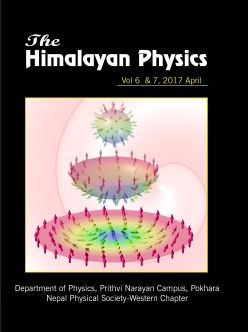Background Radiation: Detection, Measurement and Hazards
DOI:
https://doi.org/10.3126/hj.v6i0.18375Keywords:
Background Radiation, GM counter, Medical Imaging, Radiation TherapyAbstract
Radiation is a form of energy. It is of two types: non-ionizing and ionizing. Among them, ionizing radiations have hazardous health effects upon human beings. Different types of cancers may arise from the overexposure to ionizing radiations like alpha- particles, beta-particles, gamma- rays, x-rays etc. Further, ionizing radiations have very important utilities in case of paper handling and use. Radiations can be used for various beneficial purposes like medical imaging, radiation therapy, improvement of quality of agriculture, industry etc. The overall radiation from various sources on a specific location on earth's surface refers to the background radiation level of that zone. Exposure to background radiation is an inescapable feature of the environment. A portable GM counter was used to quantify the total radiation level at different places. The finding of this shows a variation of radiation level. Comparatively large values of radiation counts at high altitude and low values at river side. There is no any abnormal value of radiation counts for all sample places. So, there is, generally, no significant risk of public exposure to the background radiation for sample places.
The Himalayan Physics Vol. 6 & 7, 2017 (119-122)
Downloads
Downloads
Published
How to Cite
Issue
Section
License

The articles published in the Himalayan Physics are distributed under a license CC BY-NC-SA 4.0.




